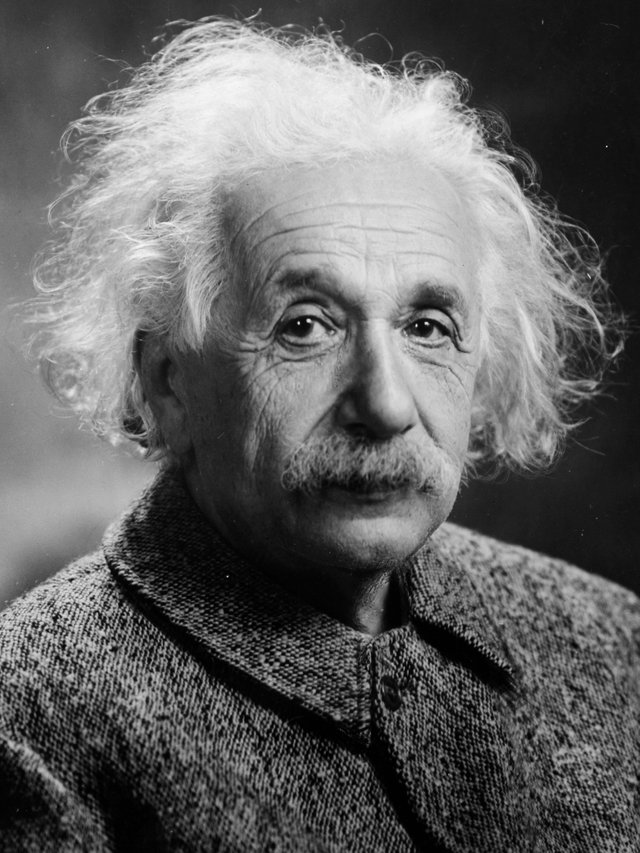Geniuses of physics - Part 1: Albert Einstein
hello friend in this new edition of geniuses of the physics I want to start talking about one of the most influential scientists of the twentieth century, I speak of Albert Einstein who with his theories revolutionized the world of sciences, then in this post we show important aspects of his scientific life.

Albert Einstein (1879-1955)
Albert Einstein German, March 14, 1879-Princeton, United States, April 18, 1955) was a German physicist of Jewish origin, nationalized after Swiss, Austrian and American. He is considered the most well-known and popular scientist of the 20th century.
In 1905, when he was a young unknown physicist, employed in the Patent Office of Berne, he published his theory of special relativity. In it, he incorporated, in a simple theoretical framework based on simple physical postulates, concepts and phenomena studied by Henri Poincaré and Hendrik Lorentz. As a logical consequence of this theory, he deduced the most popular equation of physics at the popular level: the mass-energy equivalence, E = mc². That year he published other works that would lay some of the foundations of statistical physics and quantum mechanics.
In 1915, he presented the theory of general relativity, in which he completely reformulated the concept of gravity. One of the consequences was the emergence of the scientific study of the origin and evolution of the Universe by the branch of physics called cosmology. In 1919, when the British observations of a solar eclipse confirmed his predictions about the curvature of light, he was idolized by the press.Einstein became a popular icon of world-famous science, a privilege within the reach of very few scientists .
For his explanations on the photoelectric effect and his numerous contributions to theoretical physics, in 1921 he won the Nobel Prize for Physics and not for the Theory of Relativity, because the scientist who was entrusted with the task of evaluating it did not understand it, and feared run the risk that later it would prove erroneous, at that time it was still considered somewhat controversial.
Before the rise of Nazism, Einstein left Germany around December 1932 to the United States, where he devoted himself to teaching at the Institute for Advanced Study. He became an American citizen in 1940. During his last years he worked to integrate gravitational and electromagnetic forces into the same theory.
Although he is considered by some to be the "father of the atomic bomb", he advocated world federalism, internationalism, pacifism, Zionism and democratic socialism, with a strong devotion to individual freedom and freedom of expression. He was proclaimed as the "character of the 20th century.
Most important contributions to physics
- Photoelectric effect
The theory of light quanta was a strong indication of the wave-corpuscle duality and that physical systems can show both wave and corpuscular properties. This article was one of the basic pillars of quantum mechanics. A complete explanation of the photoelectric effect could only be elaborated when the quantum theory was more advanced. For this work, and for his contributions to theoretical physics, Einstein received the Nobel Prize in Physics of 1921.

A diagram illustrating the emission of electrons from a metal plate, requiring the energy that is absorbed from a photon.
Special relativity
Theory of special relativity
Special relativity solved the problems opened by the Michelson and Morley experiment in which it had been shown that the electromagnetic waves that form light moved in the absence of a medium. The speed of light is, therefore, constant and not relative to movement.
The theory of special relativity, also called the theory of restricted relativity, is a theory of physics published in 1905 by Albert Einstein. It emerges from the observation that the speed of light in vacuum is the same in all reference systems inertial and to obtain all the consequences of Galileo's principle of relativity, according to which any experiment carried out, in an inertial reference system, will develop identically in any other inertial system.

Equivalence between mass and energy.
La Teoría de la relatividad especial estableció nuevas ecuaciones que facilitan pasar de un sistema de referencia inercial a otro. Las ecuaciones correspondientes conducen a fenómenos que chocan con el sentido común, como son la contracción espacial, la dilatación del tiempo, un límite universal a la velocidad, la equivalencia entre masa y energía o la relatividad de la simultaneidad entre otros, siendo la fórmula E=mc2 o la paradoja de los gemelos dos de los ejemplos más conocidos.
General relativity was obtained by Einstein from mathematical reasoning, hypothetical experiments (Gedanken experiment) and rigorous mathematical deduction without really having an experimental basis. The fundamental principle of the theory was the so-called principle of equivalence. In spite of the mathematical abstraction of the theory, the equations allowed to deduce verifiable phenomena.
The Extraordinary Genius of Albert Einstein - Full Documentary HD
References
1 . Alfonseca, Manuel (1996). Espasa Dictionary 1,000 great scientists. Madrid: Espasa Calpe. p. 740. P. 171
2 . Lazare Iglesis (1984). TV miniseries Hello, Einstein! (four chapters). France. Video:
3 . Einstein, Albert (November 25, 1915). «Die Feldgleichungun der Gravitation». Sitzungsberichte der Preussischen Akademie der Wissenschaften zu Berlin (in German): 844-847. Retrieved on September 12, 2006.
4 . The London Times published the following headlines on November 7, 1919: Revolution in science. New theory of the universe. The ideas of Newton overthrown.
General bibliography
- Alfonseca, Manuel (1998). Espasa Dictionary. 1,000 great scientists. Madrid: Espasa Calpe.
- Albert Einstein. (2004). "Grandes Biografías Collection, 59". Editorial Planeta-De Agostini. Barcelona, Spain.
- Amis, Martin. (2005). The monsters of Einstein. Minotauro editions. Barcelona, Spain.
- Clark, Ronald W., Einstein: The Life and Times, 1971,
- Conference on Science, Philosophy and Religion in its Relation to the Democratic Way of Life, Science, Philosophy, and Religion, A Symposium (Symposium on Science, Philosophy and Religion), New York, 1941.

excellent post friend, I really like that you have this initiative, the science of physics is fabulous, regards
Dont forget Stephen Hawking!
Of course, my friend, I'll talk about Stephen Hawking soon! regards
Congratulations @joseferrer! You have completed some achievement on Steemit and have been rewarded with new badge(s) :
Click on any badge to view your own Board of Honor on SteemitBoard.
For more information about SteemitBoard, click here
If you no longer want to receive notifications, reply to this comment with the word
STOPAn important person who, unfortunately, like so many geniuses, as for example Nietzsche, was demonstrably suffering from an affective psychosis, was therefore mentally ill.